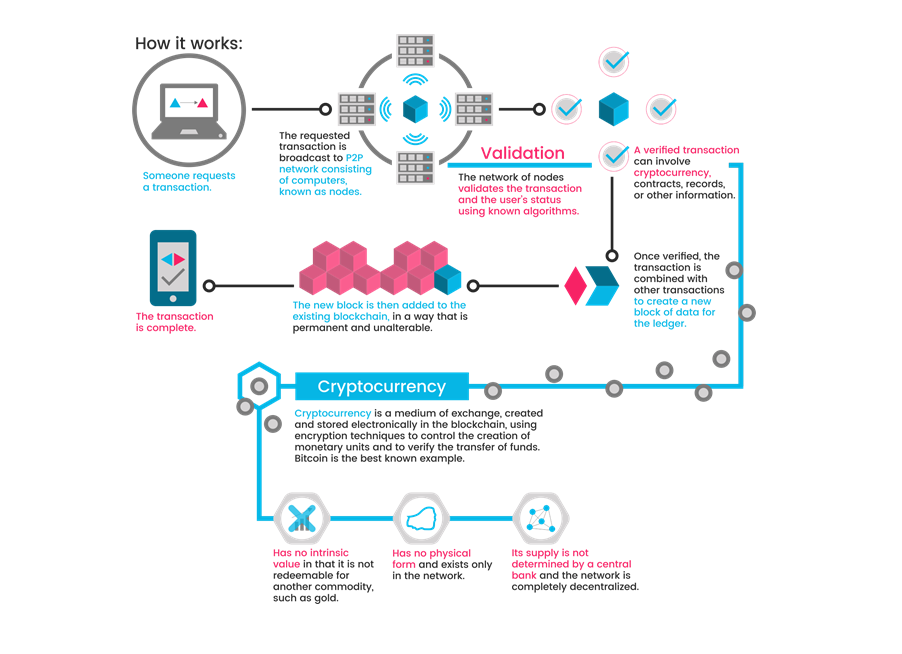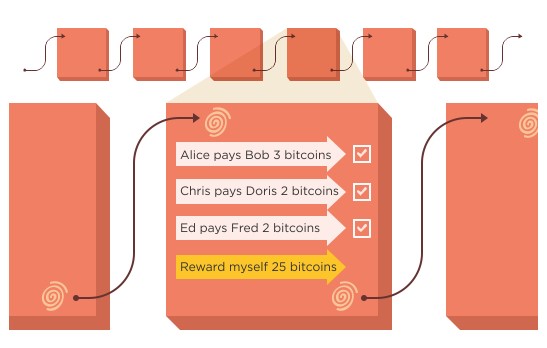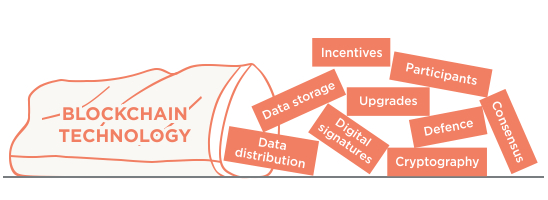
What if I told you that the technology needed to change the way economy, governance, and business function already exists, and it’ll alter the concept of ownership, trade, and trust? Heralded as a paradigm shifter, blockchain technology aims to disrupt the global business stage, transitioning from centralized recordkeeping to a collective bookkeeping via the internet. Here’s how it works, and why.
Blockchain was originally built to sustain cryptocurrencies like the Bitcoins by forming a globally distributed database synchronized across millions of computers — a single source of truth accessible to everyone. At its most basic, Blockchain functions as a decentralized, universal ledger that keeps track of anything of value — money, intellectual property, votes, music, art, titles, and even deeds.
Compared to traditional commerce, which relies on third parties and intermediaries like banks, governments, notaries, and accountants to oversee and record trade, Blockchain takes a radically different approach that uses computer networks to maintain “collective bookkeeping.” This way, transactions are unburdened by bottlenecks, and financial information is transparent and publicly available in one distributed record — called “the blockchain.”
Information on the blockchain exists as a shared, continually reconciled database possessed by all the computers (nodes) connected to the network. With every new transaction logged, each node automatically downloads the latest version of the blockchain.
Security and authentication
Authenticity and read/write access rights are verified using advanced cryptography and digital signatures, preventing anyone from corrupting the data. The underlying mathematics ensures that nodes continuously agree about the state of the ledger and each transaction within. Since transactions stored as “blocks” contain a log of the time, date, participants, and the amount exchanged, each node in the network must unanimously agree that a transaction has occurred on date X at time Y. Otherwise, it won’t be included in the blockchain.

As every block contains a hash of the previous block, anyone can independently verify how much value belonged to each address at any point in its history. Nodes on the network compete to validate the transactions by “mining,” proving the party that sent the transaction rightfully owned it in the first place.
Blockchain vs. Torrent
On the surface, blockchain technology resembles the peer-to-peer data sharing involved in Torrenting, but blockchains don’t duplicate the commodity being shared and don’t store actual Bitcoins. Instead, blockchains contain the transactions that actualize the exchange, acting as one massive, worldwide pool of every existing bank statement to keep track of all bitcoin allocations. Every node is an “administrator” of the blockchain and joins the network voluntarily; in that sense, the network becomes decentralized.
Copying the blockchain has no effect on wealth distribution in the same way that copying a bank statement doesn't increase wealth.
Simply put, Blockchain is a collection of multiple technologies that contain a standard database, along with software that adds new rows, validates that the new rows conform to pre-agreed rules, and shares the new rows with its peers across the network, ensuring that all participants have the same database.

Who will use Blockchain?
Decentralization and transparency aside, a prime benefit of blockchain technology is its ability to assign properties to the asset it represents and create “smart contracts” with built-in compliance. Software can program self-executing instructions on blockchains that trigger when specific conditions are met, eliminating the need to enforce contracts bureaucratically.
By working autonomous agents directly into the asset itself, Blockchain may also eliminate coordinating costs and streamline business transactions. For example, the World Bank estimates that over $430 billion in money transfers were sent in 2015; with Blockchain, the entire middleman fees could be abolished.
The bottom line is that Blockchain permits internet users to create value and authenticates digital information independently. By allowing digital information to be distributed and not copied, blockchains create the foundation for an entirely new type of internet. Digital currency was just the beginning.

Source: Blockgeeks , Harvard Business Review , Chimera.labs.oreilly , Bitsonblocks.net , and YouTube
Advertisement
Learn more about Electronic Products Magazine





